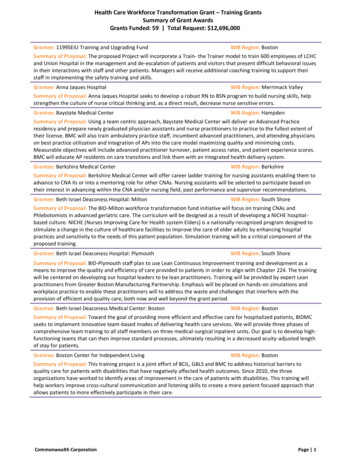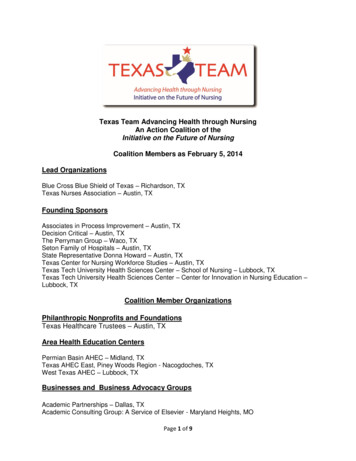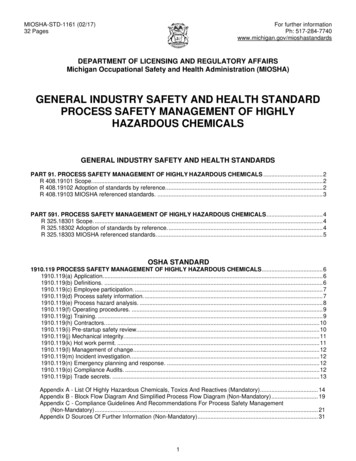
Transcription
Transformation of Health Industry Through Performance PyramidAuthor: Mr. Raj Shah, CEO, CTIS Inc.Providing Excellent End-to-End Healthcare to the Population with a 30%Reduction in Cost and Time.
The Digital Health Forest: Health Information EconomyTransformation of Health Industry Through Performance PyramidINTRODUCTIONThe American health industry costs 3trillion today, represents 18% of the GDP,and is expected to grow to over 4 trillionand 25% of GDP by 2020. However, thisdoes not cover the 20% of the population(60 million) who would require universalcoverage and innovative sustainabledisease management mechanisms suchas: advances in science and technology,convergence of its segments (publichealth, health research, healthcare andhealth education, etc.) and substantialreduction in fragmentation and fraud. Theindustry, made up of government, nonprofit, and commercial organizations,needs to harmonize and develop a plan that covers all of its stakeholders while deliveringa high Return On Investment (ROI).The solution is there; this paper discusses the proven concept and execution process.Imagine if we treated the health Industry as a pyramid, the most sustainable, efficient,organized, and long-lasting structure in the world. If one reorganizes the health industryin that context, one can better understand and therefore deliver complete healthcarecoverage to the public with high ROI. It is possible that with the use of health IT, processreengineering, organization optimization, and stakeholder collaboration one can reducethe healthcare cost by 30%, while providing the best patient care. Copyright 2016 CTISCTIS Confidential & Proprietarywww.ctisinc.com2
The Digital Health Forest: Health Information EconomyTransformation of Health Industry Through Performance PyramidTHE PERFORMANCE PYRAMIDThe pyramid has a base that describes theoverlapping healthcare segments and theirinterrelationships. The four sides depict theorganization structure and management ofthe government side of the industry; theneeded framework for building universalhealthcare and disease management; theperformance mechanisms’ to deliver highROI and best patient care; and informationtechnology solution components thatdeliver the outcome.The Base of the pyramid describes theoverall health industry describing the major segments of the industry: Public Health: Population is managed for awareness, surveillance, control,prevention, and epidemiology of disease.Health Research: Research, discovery, development, and delivery of newtherapies, treatments, drugs, devices, and technologies for diseasemanagement.Healthcare: Providers, such as hospitals, clinics, and other facilities, servethe patients through physician care.Health Education: All stakeholders are trained by academic medical andresearch institutes, hospitals, community colleges, associations, and theprivate industry.Policy: The government defines, designs, develops, deploys, andadministers programs.Communication: Proper outreach of information through local, regional,national, and international media.Networking: Public and private stakeholders, associations, foundations, andtrade organizations come together to tackle the industry problems, run Copyright 2016 CTISCTIS Confidential & Proprietarywww.ctisinc.com3
The Digital Health Forest: Health Information EconomyTransformation of Health Industry Through Performance Pyramid conferences, and hold workshops in science, technology, policy, andsolutions.Technology: IT and other technologies are developed, implemented, andoperated to serve patient needs across the industry (healthcare provider,research, and education facilities).The First Side of the pyramid depicts government management and governance: Thisside describes The Health and Human Services federal level and its various departmentsto manage health problems. Copyright 2016 CTISCTIS Confidential & Proprietarywww.ctisinc.com4
The Digital Health Forest: Health Information EconomyTransformation of Health Industry Through Performance PyramidBeginning with the bottom layer:NIH: National Institutes of Health conducts research to find new treatments, therapies,drugs, and devices for preventative, diagnostic, and interventional treatments.CDC: Centers for Disease Control provides needed information for awareness,preparedness, surveillance, prevention, and management of onset of the both infectiousand chronic diseases.CMS: Center for Medicaid and Medicare provides cost coverage for those with chronicdiseases, the elderly, and the disabled and underserved while providing intelligence toother institutes about patterns in the population.FDA: Food and Drug Administration provides governance in approval of new drugs anddevices and oversees food processing to assure population safety.SAMHSA and ATSDR: Substance Abuse and Mental Health Services Administration andAgency for Toxic Substances and Disease Registry provide services to manage thespecial needs and support to this segment of the population.ACF and AoA: Administration of Children and Family and the Administration of Agingprovide services to manage special needs of children, family, and elderly.ONCHIT and Health IT: Office of National Health Information Network for InformationTechnology provides policy, guidelines, and program support to build IT infrastructure,architecture, technologies, and processes to have universal Electronic Health Record(EHR) and Personal Health Record (PHR) for the population.AHRQ: Agency for Healthcare Research and Quality provides outcome performancemeasures, quality requirements, and research support across the health industry needs. Copyright 2016 CTISCTIS Confidential & Proprietarywww.ctisinc.com5
The Digital Health Forest: Health Information EconomyTransformation of Health Industry Through Performance PyramidHRSA: Health Resources and Services Administration provides oversight across thehealth industry for outcome performance measures, quality requirements, and researchsupport, with special emphasis on health disparity.HHS: Health and Human Service headquarters carries out governmental policy, program,management, and implementation responsibilities to serve the healthcare needs of thepopulation as a whole.The Second Side of the pyramid depicts the major emphasis areas that would makehealth care universal: Copyright 2016 CTISCTIS Confidential & Proprietarywww.ctisinc.com6
The Digital Health Forest: Health Information EconomyTransformation of Health Industry Through Performance PyramidBeginning with the bottom:Personal: Healthcare needs to be on individual basis. Although diseases may be similar,every human being needs to be individually managed due complex and individualmechanisms requiring the right combination of drugs and therapies. With the recentdevelopments in science in biology and the advent of translational research, this is nowpossible.Participatory: Collaboration between stakeholders, especially among physicians andpatients, is needed to improve patient lives and provide better and faster cures andmaintenance of the diseases.Predictive: Technology exists to predict the predisposition and pre-symptomatic stagesof many diseases. The highest priority should be placed on screening, diagnostics, andprevention.Preemptive: A companion to predictive mechanisms, preemptive efforts will not onlyimprove patient lives but also save substantial cost to healthcare industry.Health disparity, chronic care, and elder care: These three segments requireoverlapping needs and covers over 65% of the overall healthcare budget. Focusing onimprovements across public health, health research, healthcare, and education amongthis population will not only serve the national interest, but also save substantial costs.New sciences and technology: The ultimate success in healthcare is to come frominvestments in science, such as biological, genomics, proteomics, clinical, medical, andtranslational, and the technologies of physics, chemistry, nano, information,computational, energy, and environment.EHR/PHR and NHIN: Ultimate success will come from covering all of the population inthe prevention and management of their diseases while contributing substantially to thenational economy through having a Nationwide Health Information Network that would Copyright 2016 CTISCTIS Confidential & Proprietarywww.ctisinc.com7
The Digital Health Forest: Health Information EconomyTransformation of Health Industry Through Performance Pyramidprovide to every citizen an EHR and PHR, which will substantially contribute to the bestpatient care and lowest cost.The Third Side of the pyramid depicts how to build the highest return on investment,while best serving patients. This performance side of the pyramid needs to beimplemented across the whole healthcare industry:Beginning with the bottom:People Productivity: An implementation of information technology and othercommunication mechanisms will improve people productivity by increasing throughputper stakeholder (e.g. being able to see more patients per day without comprising care). Copyright 2016 CTISCTIS Confidential & Proprietarywww.ctisinc.com8
The Digital Health Forest: Health Information EconomyTransformation of Health Industry Through Performance PyramidProcess Efficiency: To reduce time in care, such as reducing time in clinical trialactivation, the industry needs to streamline processes and eliminate rate limiting stepsand bottlenecks to speed up the process.Organization Effectiveness: Institutional review boards and data safety managementboards need to eliminate, merge, realign, or reorganize various overlapping andduplication functions to make organization more effective in their role.Information Sharing: The industry needs to provide all stakeholders, especiallyphysicians and patients, the right information at the right time to help manage diseaseand provide for better patient care. For example, this will avoid adverse events with drugcombinations or timely intervention and collaboration between doctors for specific patientneeds.Faster endpoints, quality outcome, and evidence-based results: The impact of thebottom layer will be increasing the speed to get to the endpoint in decision-making fortreatment, better quality outcome, and the ability to measure results based on evidenceto apply to the other patients in a cohort and, ultimately, population. IT will deliver betterprevention and intelligence for the population on an individual, cultural, regional, andnational level.Patient safety and drug efficacy: The impact of the last layer is more safety for patientsand higher efficacy for drugs due to adherence to standards, regulatory compliance, andquality.ROI, ROV, and EVM: The ultimate value of this side of the pyramid is overall best patientcare, full coverage in population, and reduction in costs and time to deliver healthcareservice, as measured through standard ROI and Earn Value Management (EVM)practices.The Fourth Side of the pyramid depicts how a well defined, designed, developed, anddeployed informatics solution can deliver the desired performance outcome: Copyright 2016 CTISCTIS Confidential & Proprietarywww.ctisinc.com9
The Digital Health Forest: Health Information EconomyTransformation of Health Industry Through Performance PyramidBeginning with the bottom layer:Infrastructure: A robust IT and telecom infrastructure that is compliant with meetingstringent federal government (FISMA), industry (ITIL), and the needed privacy protection(HIPAA) standards is central to the success of building a proper performance informaticssolution.Architecture: An open and service oriented architecture that facilitates open source,interoperability, and scalability among information systems that make data sharing viableis core to the success of building a proper performance informatics solution.Engines: Appropriate data management, documents management, and workflowengines that facilitate proper information capture, management, analysis, dissemination,and archiving is central to the success of building a proper performance informaticssolution. Copyright 2016 CTISCTIS Confidential & Proprietarywww.ctisinc.com10
The Digital Health Forest: Health Information EconomyTransformation of Health Industry Through Performance PyramidInformation: Sourcing the right information from the right sources; proper acquisition,validation, integration, harmonization, and usage of that information in decision-makingprocesses; business intelligence; outcome decisions; and patient care is critical to thesuccess of building a proper performance informatics solution.Regulatory compliance, best practice, and standard measures: Meeting all aspectsof the regulatory requirements, best practice mechanisms, and standards-basedmeasures across all service domains such as clinical services (good clincial services,Code of Federal Regulations), software development (Capability Maturity Model andRational Unified Processes), program management (Project Management Certifications,Earn Value Management), customer services (Six Sigma and total quality management)and operational services (CDISC and HL7 and ISO) is critical to the success of buildinga proper performance informatics solution.Applications: Building appropriate applications that serve the specific purpose of publichealth, health research, healthcare, and health education with the right functions,features, and benefits, which utilize the capacity of the bottom two layers, is central to thesuccess of building a proper performance informatics solution.Tools and platforms: Building applications using standardized tools and a commonplatform will not only speed up the development and upgrade process, but also improveupgrade and maintenance while also delivering better interoperability and scalability,saving time and cost, and improving quality.The final solution is a data warehousing system integrated with all other informaticssolutions that will provide the needed information anytime, anyplace, and through anydevice to all relevant stakeholders. This system will be compliant will all regulatorystandards and best practices and will be cheaper, better, and faster in serving thestakeholders’ needs, therefore saving patients’ lives. Copyright 2016 CTISCTIS Confidential & Proprietarywww.ctisinc.com11
The Digital Health Forest: Health Information EconomyTransformation of Health Industry Through Performance PyramidConclusionThe performance pyramid shows that through proper use of IT, process reengineering,and organization optimization, one can take the waste, gaps, duplication, andfragmentation currently found in the overall health industry and transform it into a end-toend care solution for the whole population while reducing cost. This can be achieved in10 years and will reduce the cost by 30% or over a trillion dollars. CTIS has developed aproof of concept for this application through their work at NIH, which has been validatedby the NIH director awards and OMB calculations. Copyright 2016 CTISCTIS Confidential & Proprietarywww.ctisinc.com12
THE PERFORMANCE PYRAMID The pyramid has a base that describes the overlapping healthcare segments and their interrelationships. The four sides depict the organization structure and management of the government side of the industry; the needed framework for











